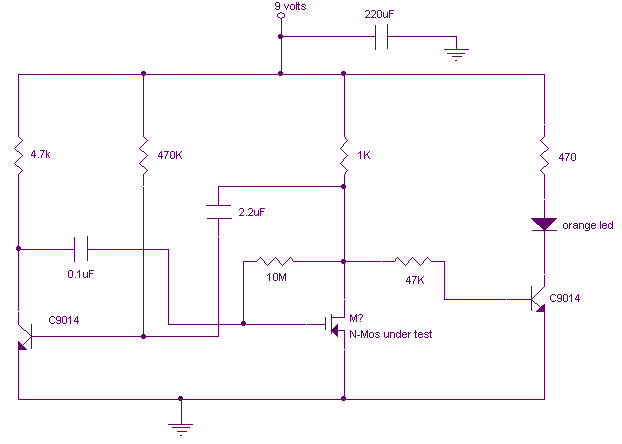
MOSFET Tester circuit

This is a variation on the astable multivibrator. Circuit was recently developed to test for N-mosfets (the power kind e.g. irf830). I don't claim circuit can test all bad mosfets or all fault mosfet conditions. If mosfet is working it will operate in the astable multivibrator circuit causing the LED to flash. A bad mosfet will not cause the LED to flash. Below is the circuit diagram, the other half of the astable utilizes an npn transistor to make the circuit cheap. Almost any npn transistor will work in this circuit. The npn transistor to the right is used as a common emitter buffer that also drives the LED as it receives pulses from the mosfet drain.
The circuit described is a specialized astable multivibrator designed for testing N-channel MOSFETs, such as the IRF830. The operation of the circuit hinges on the ability of the MOSFET to switch on and off, which is indicated by the flashing of an LED. The astable multivibrator configuration allows for continuous oscillation, generating a square wave output that can be used to drive the LED.
In the circuit, the astable multivibrator is constructed using two transistors, one of which is an NPN transistor. This NPN transistor is utilized as a common emitter buffer, which serves to amplify the signal from the drain of the MOSFET. The transistor's base receives pulses that indicate whether the MOSFET is functioning correctly. When the MOSFET is operational, it will allow current to flow, causing the LED to flash in response to the oscillations generated by the astable multivibrator.
The choice of the NPN transistor is flexible, as nearly any standard NPN transistor can be employed in this configuration, making the circuit cost-effective. The simplicity of the design allows for easy construction and troubleshooting, as well as the ability to test a wide range of MOSFETs. However, it is important to note that this circuit may not be capable of identifying all fault conditions in MOSFETs, as it primarily indicates whether the device is conducting or not.
Overall, this astable multivibrator circuit serves as a practical tool for quickly assessing the functionality of N-channel MOSFETs, providing a visual indication of their operational status through the LED.This is a variation on the astable multivibrator. Circuit was recently developed to test for N-mosfets(the power kind e.g irf830). I don?t claim circuit can test all bad mosfets or all fault mosfet conditions. If mosfet is working it will operate in the astable multivibrator circuit causing the Led to flash. A bad mosfet will not cause the LED to flash. Below is the circuit diagram, the other half of the astable utilizes an npn transistor to make the circuit cheap. Almost any npn transistor will work in this circuit. The npn transistor to the right is used as a common emitter buffer that also drives the led as it receives pulses from the mosfet drain.
🔗 External reference
The circuit described is a specialized astable multivibrator designed for testing N-channel MOSFETs, such as the IRF830. The operation of the circuit hinges on the ability of the MOSFET to switch on and off, which is indicated by the flashing of an LED. The astable multivibrator configuration allows for continuous oscillation, generating a square wave output that can be used to drive the LED.
In the circuit, the astable multivibrator is constructed using two transistors, one of which is an NPN transistor. This NPN transistor is utilized as a common emitter buffer, which serves to amplify the signal from the drain of the MOSFET. The transistor's base receives pulses that indicate whether the MOSFET is functioning correctly. When the MOSFET is operational, it will allow current to flow, causing the LED to flash in response to the oscillations generated by the astable multivibrator.
The choice of the NPN transistor is flexible, as nearly any standard NPN transistor can be employed in this configuration, making the circuit cost-effective. The simplicity of the design allows for easy construction and troubleshooting, as well as the ability to test a wide range of MOSFETs. However, it is important to note that this circuit may not be capable of identifying all fault conditions in MOSFETs, as it primarily indicates whether the device is conducting or not.
Overall, this astable multivibrator circuit serves as a practical tool for quickly assessing the functionality of N-channel MOSFETs, providing a visual indication of their operational status through the LED.This is a variation on the astable multivibrator. Circuit was recently developed to test for N-mosfets(the power kind e.g irf830). I don?t claim circuit can test all bad mosfets or all fault mosfet conditions. If mosfet is working it will operate in the astable multivibrator circuit causing the Led to flash. A bad mosfet will not cause the LED to flash. Below is the circuit diagram, the other half of the astable utilizes an npn transistor to make the circuit cheap. Almost any npn transistor will work in this circuit. The npn transistor to the right is used as a common emitter buffer that also drives the led as it receives pulses from the mosfet drain.
🔗 External reference





